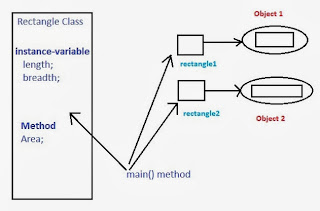A class can be defined as a logical structure which
contains data and code. To implement anything in Java you have to use class.
The class defines a new type. With the help of class you can create objects of
type class. You can create any number of objects of a class.
When you deal with class you will often listen these three words, instance-variables, object of class and
methods of class.
Instance-variables are the
variables declare within the class to hold the data. They are referred as instance-variable
because each instances of class or objects of class will have their own copy of
these variables (instance-variables). Method contains code or business logic.
In Java, Class is created
using the keyword class.
Below you
can see the general syntax of class:
class SampleClass
{
type instance-variable1;
type
instance-variable2;
…………………………….
type instance-variableN;
SampleClass object1=new SampleClass();
SampleClass object2=new SampleClass();
………………………………… // objects and its
reference variable are created.
SampleClass objectN=new SampleClass();
type method-name1 (parameter1,parameter2,…)
{
//body of method
}
……………………………..
type method-nameN (parameter1,parameter2,…)
{
//body of method
}
}
The variables defined within the class are
called instance-variables. The codes or business logics are written inside the
methods. The objects and its reference
variables are created using the code fragment mentioned in the general syntax.
i.e.
SampleClass object1=new
SampleClass();
Where, object1 is the
reference variable to the object which holds the reference value i.e. the
address location of object. The new keyword is used to allocate memory for the class
object. The SampleClass() is the constructor of the class.
The above fragment can also be rewritten
as the below.
SampleClass object1;
This code fragment only
declares the variable of type SampleClass. And the value of object1 is null at
this point.
object1=new
SampleClass();
After the execution of
this code fragment, object1 is dynamically assigned with the reference value i.e.
address of memory location of object created.
Below picture is used to explain the above statements:
Let us see a
simple program example. Here we will create a class called Rectangle. And
create objects of this class to study the behavior of objects.
package sample.example1627;
public class Rectangle
{
double length;
double breadth;
double Area()
{
return length*breadth;
}
}
package sample.example1627;
public class WorkingRectangle
{
public static void main(String[] args)
{
Rectangle rectangle1=new Rectangle(); // object created
Rectangle
rectangle2=new Rectangle(); // object created
rectangle1.length=50; // initializing variable
length
rectangle1.breadth=60; // initializing variable
breadth
rectangle2.length=100; // initializing variable
length
rectangle2.breadth=200; // initializing variable
breadth
System.out.println("Area of rectangle
object1 "+rectangle1.Area());
System.out.println("Area of rectangle
object2 "+rectangle2.Area());
}
}
Output:
Area
of rectangle object1 3000.0
Area of rectangle
object2 20000.0
From the above program
example it is clear that two different objects are created and each object will
have its own copy of instance-variable. And no two objects will interfere with
each others’ data. In the above program
example you can see that the value of area calculated by two different objects are different.
In the above diagram, you
can notice two objects of rectangle class are created and both are
allocated
space in two different memory locations and rectangle1 and rectangle2
are reference variables holding the address location of their respective
objects. And each object created has its own
length and breadth.
The class can also be
defined as the blueprint from which you can create individual objects. The visibility
of class to other classes or code in same package or other package can be controlled
by using access specifiers like public,
protected, default.

